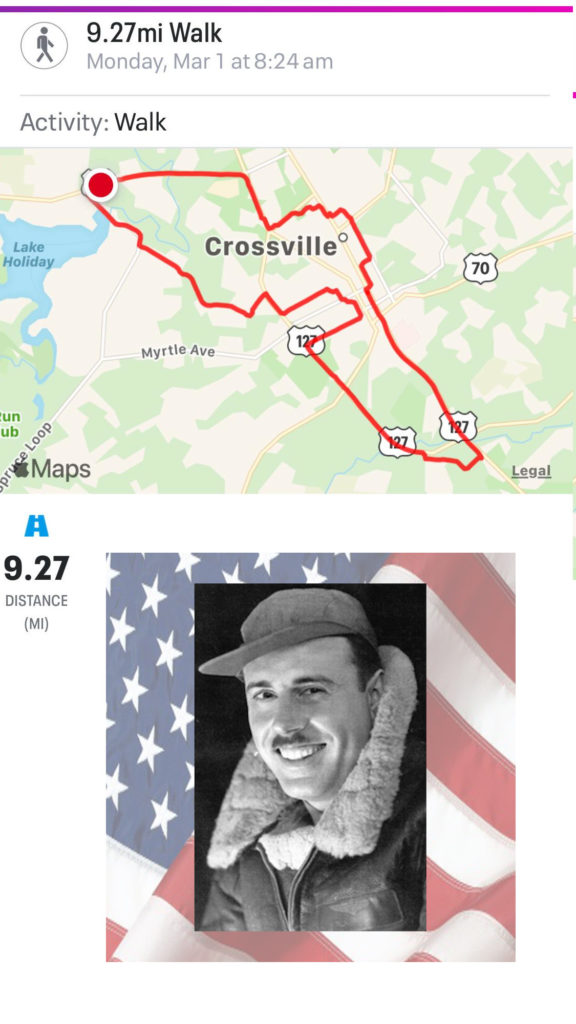My walk today was dedicated in honor of:
Navy Veteran LT CMR Adrian Marks, Age 81 of Ladoga, IN.
Died Mar 7, 1998
Adrian was born on 18 February 1917 in Ladoga, IN,
Marks graduated from Northwestern University and Indiana University Law School before the war. He joined the U.S. Navy and was stationed at Pearl Harbor when the Japanese attacked on 7 December 1941. He later attended flight school, was designated as a Naval Aviator and served as an Instructor at Pensacola Naval Air Station, FL, before going to the Pacific.
At the end of July 1945, the USS Indianapolis was underway to the Philippines from Guam after stopping at Tinian Island to deliver critical parts for the atomic bombs that were to be dropped on Hiroshima and Nagasaki. It had no escort. In the South Pacific, at 14 minutes after midnight on 30 July, the Indianapolis was spotted by the Japanese submarine I-58. The submarine skipper, Lt. Cmdr. Mochitsura Hashimoto, ordered the firing of six torpedoes; two of which struck the Indianapolis. Rocked by the explosions, Indianapolis rolled over and, within twelve minutes, she was on her way to the bottom of the Pacific. Hundreds of men went overboard into shark-infested waters; most of them without life rafts.
Due to an error, no distress message was sent or, if one was, no one ever reported hearing it. The Navy didn’t know the Indianapolis was missing and, because of slip-ups and bureaucratic lapses, Navy commanders didn’t think to look for the Indianapolis, even when it became officially overdue at Leyte Gulf, the Philippines.
With a total crew of 1196 men, about 400 men perished immediately and about 800 went over the side. All through Monday, Tuesday and Wednesday, the survivors of the torpedo attack —
suffering from injuries, sunburn, dehydration, and menaced by sharks — thrashed about in the sea. By Thursday, 2 August, only 320 of the men were still alive. Then, at about 10 a.m., Navy pilot William Gwinn, flying a routine mission in a land-based patrol plane, spotted figures bobbing in the water. The plane could not land and its radio antenna was tangled, so the message it sent was garbled and wasn’t fully received. However, the message indicated that they had spotted a life raft.
Lieutenant Commander Adrian Marks, summoned from the island of Peleliu, took off in his Catalina amphibious patrol plane (PBY5A) to investigate the sighting. Marks was flying a seaplane designed for landings only in calm water and his was the first rescue plane to arrive. He dropped three life rafts in the late afternoon, but one broke up when it hit the water.
Marks then polled his crew members about whether they should make a dangerous open-sea landing that was forbidden by regulations. Knowing they were risking their lives, they agreed that they should attempt to land. Marks set down his Catalina plane amid 12-foot swells. The plane bounced 15 feet in the air after hitting the waves, but incurred only slight damage. Thus began a dramatic mass rescue following the worst disaster at sea in American Naval history.
Marks and his crew quickly realized that they could not rescue everyone and heartbreaking decisions would have to be made. They decided that the men in groups stood the best chance of survival. In groups they could look after one another, could splash and scare away the sharks and could lend one another moral support and encouragement.
Marks’ crewmen first picked up the men who were alone by throwing life rings attached to ropes to the men. Soon there were two survivors in each bunk on the plane, and then men were lying two and three deep in all the compartments. Marks later shut off the engines and put additional survivors on the bobbing wings, tying the last of the 56 men down with parachute material.
Then night came. Although they were near the equator, the wind whipped up. They had long since dispensed the last drop of water, and scores of badly injured men were softly crying with thirst and pain. Then, far out on the horizon, there was a light that turned out to be the
destroyer USS Cecil J. Doyle, the first of seven rescue ships that were belatedly dispatched. The survivors were hauled onto the Doyle, followed by Marks and his crewmen, and the Doyle and other ships later fished others out of the water. When morning arrived, the Doyle sank Marks’ plane, which was now too damaged to fly again.
Twelve days later Japan surrendered ending World War II.
Marks later had the Air Medal pinned on him by Fleet Admiral Chester Nimitz, Commander-in-Chief of the Pacific Fleet.
After the war, Marks returned to his Frankfort, IN, home — some 40 miles from Indianapolis — and opened a law practice, specializing in real-estate titles and deeds.
Lieutenant Commander Adrian Marks died on 7 March 1998 at Clinton County Hospital in his hometown of Frankfort, IN. He was 81. Marks was cremated and his ashes scattered.
He is survived by his wife, Elta; a son, Robert, of Bellevue, WA; three daughters, Pamela Levine of Lakeville, MA; Alexis Shuman of Enumclaw, WA; and Lynn Larson of Olympia, WA; a foster son, John Barlas, of Mercer Island, WA; and 10 grandchildren.
We had an amazing 9.27 Mile walk. We walked by the Boats & Harbor store and seen the big boat anchor in the window and then walked out to the American Legion Post 163 Boat Anchor Memorial Display. We stopped by the War Memorial Park down town. We had a great walk. I want to thank all who honked, waved, and saluted in helping me honor this hero. It was amazing.
Navy Veteran LT CMR Adrian Marks will not be forgotten !




